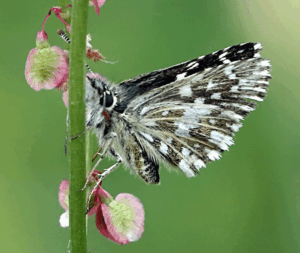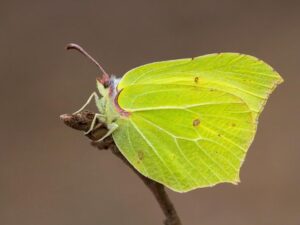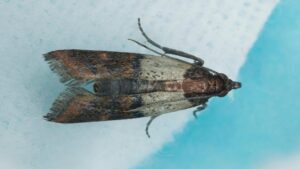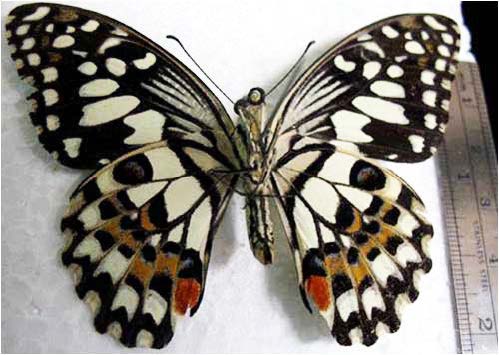
Lime Swallowtail
The Lime Swallowtail, Papilio demoleus is a common and widespread swallowtail butterfly. The butterfly is also known as the lime butterfly, lemon butterfly, lime swallowtail, and chequered swallowtail. These common names refer to their host plants, which are usually citrus species such as the cultivated lime.
Did you know?
Unlike most swallowtail butterflies, it does not have a prominent tail.
Papilio demoleus is a common and widespread swallowtail butterfly. The butterfly is also known as the lime butterfly,lemon butterfly, lime swallowtail, and chequered swallowtail.These common names refer to their host plants, which are usually citrus species such as the cultivated lime. Unlike most swallowtail butterflies, it does not have a prominent tail. When the adult stage is taken into consideration, the lime swallowtail is the shortest-lived butterfly, with male adults dying after four days and females after a week.The butterfly is native to Asia and Australia, and can be considered an invasive pest in other parts of the world.[The butterfly has spread to Hispaniola island (Dominican Republic) in the Western Hemisphere, and to Mahé, Seychelles.
LIME SWALLOWTAIL PAPILIO DEMOLEUS LINNAEUS (INSECTA: LIPIDOPTERA: PAPILIONIDAE)
The Featured Creatures collection provides in-depth profiles of insects, nematodes, arachnids and other organisms relevant to Florida. These profiles are intended for the use of interested laypersons with some knowledge of biology as well as academic audiences.
The lime swallowtail, Papilio demoleus Linnaeus, is sometimes called the chequered or citrus swallowtail. This butterfly ranges widely and is an extremely successful invader. Its proliferation appears to be aided by agricultural land use and urbanization that create new, suitable, open habitat and enhanced availability of resources.
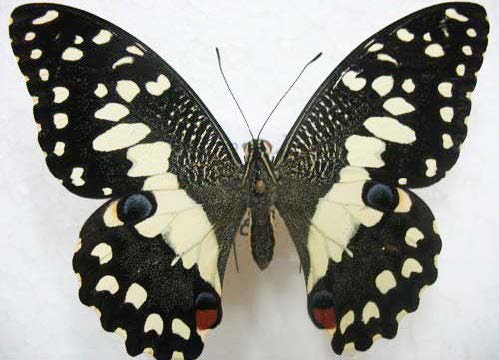
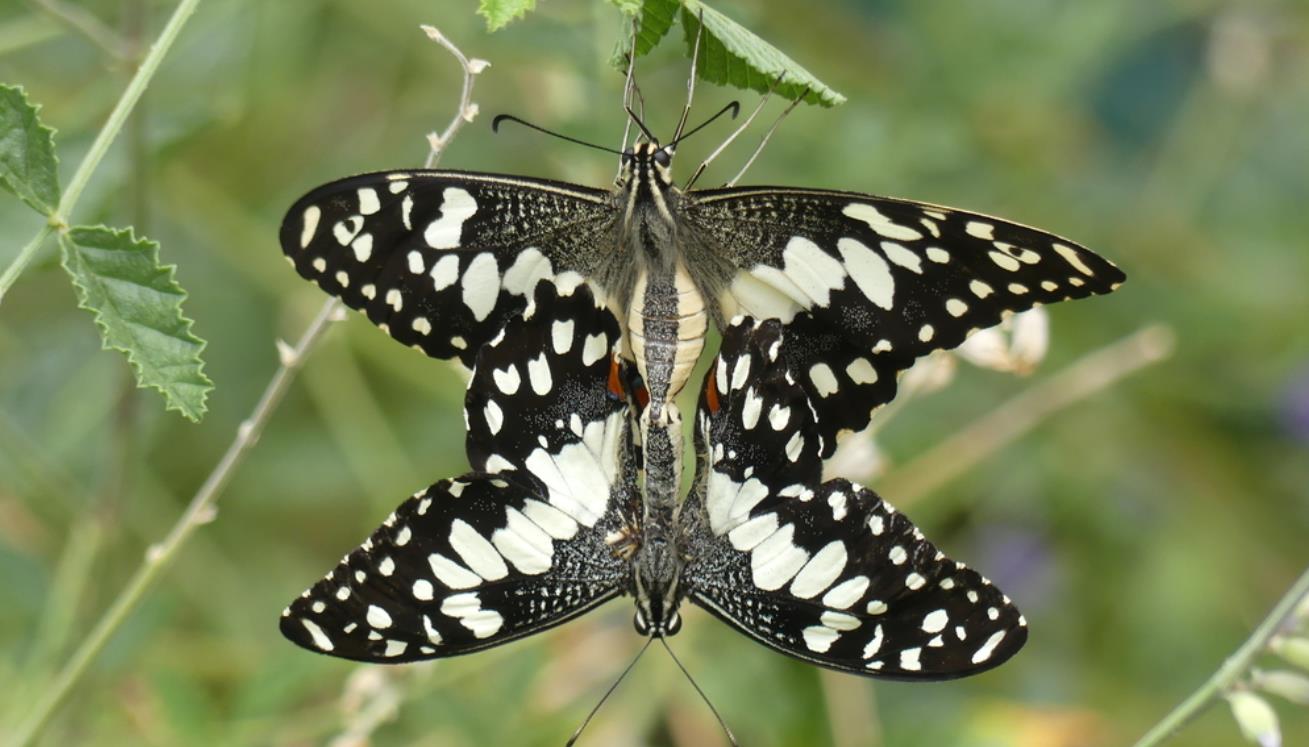
Papilio demoleus is a large butterfly with a wingspan of up to 10 cm. The forewings (upper wings) are mostly black with irregular yellow spots on the outer wing margins. The hindwings (lower wings) have a distinctive red spot with blue scales and a discal black band with yellow scales. The underside is a paler yellow with black sections containing more yellow than the upper side of the wings. It does not have the “tails” that extend from the hindwings of most swallowtail butterflies. Lime swallowtail eggs are laid on the surface of tender leaves and twigs and are creamy yellow in appearance, spherical, and flattened at the base. Larvae in the first four instars have a distinct V-shaped white mark that extends from the anterior to the posterior as well as a series of short fleshy spines on the front sides and thorax. Larvae in these early stages have a black head and resemble a bird dropping in appearance. As larvae grow into their fifth instar, they become more cylinder-shaped, their spines change from a yellow-orange hue to green, and the body overall becomes predominantly green to yellowish-green in color.
History
Papilio demoleus was first found in the Dominican Republic in March 2004 and had spread to Puerto Rico in 2006. There are no official detections of this species in California, however an unofficial specimen was collected in August 2020 in Los Angeles County. Two other reports of P. demoleus were submitted through the citizen science website, iNaturalist in the same year, one from Los Angeles County and the other in San Luis Obispo County. The lime swallowtail is a strong flier and therefore can spread into some regions of California if left unchecked.
Distribution
Papilio demoleus is native to the subtropical and tropical areas of southern Asia, ranging from the Middle East to India and southern China to Japan. Subspecies of P. demoleus are also found in Malaysia, New Guinea, and Australia. Recently, lime swallowtail has found its way into North America, having been recorded in the Dominican Republic, Puerto Rico, and Jamaica.
Life Cycle:
Papilio demoleus eggs are laid singly on the leaves of a host plant. The larval stage includes five instars, with the first four instars having a similar body coloration. Early instar larvae have the appearance of bird droppings which is used as a defensive camouflage to protect themselves from being eaten by predators. In the fifth instar, larvae become predominantly green. The pupae vary from a green to straw-brown color. In laboratory environments, adults emerged from their pupae around 24 to 26 days after eggs were laid, with female adults tending to live longer than males. The development of P. demoleus is more rapid at higher temperatures. In Puerto Rico, the time required to complete a life cycle is reported to be approximately 30 days and 12 generations may be possible per year. Fewer generations are reported in milder climates.
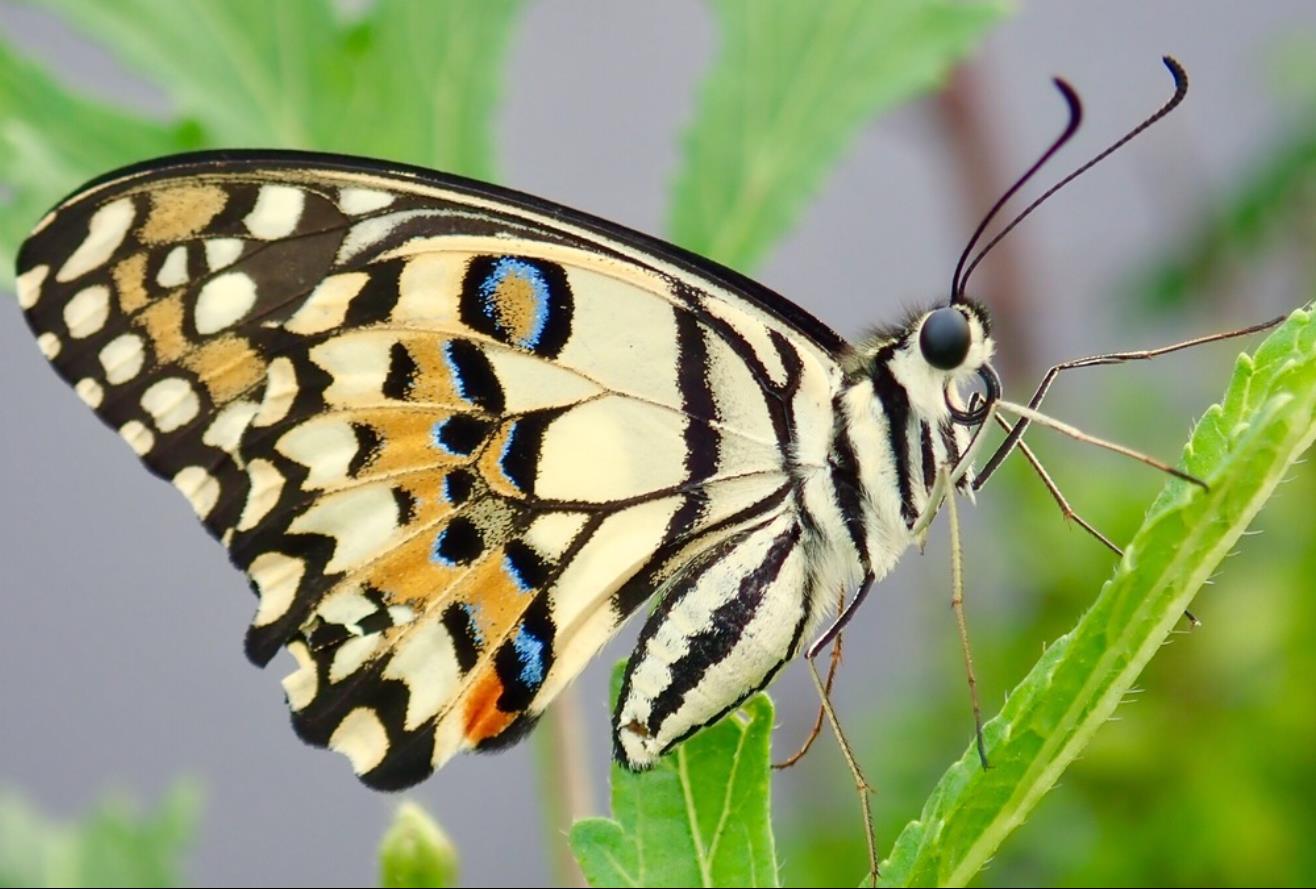
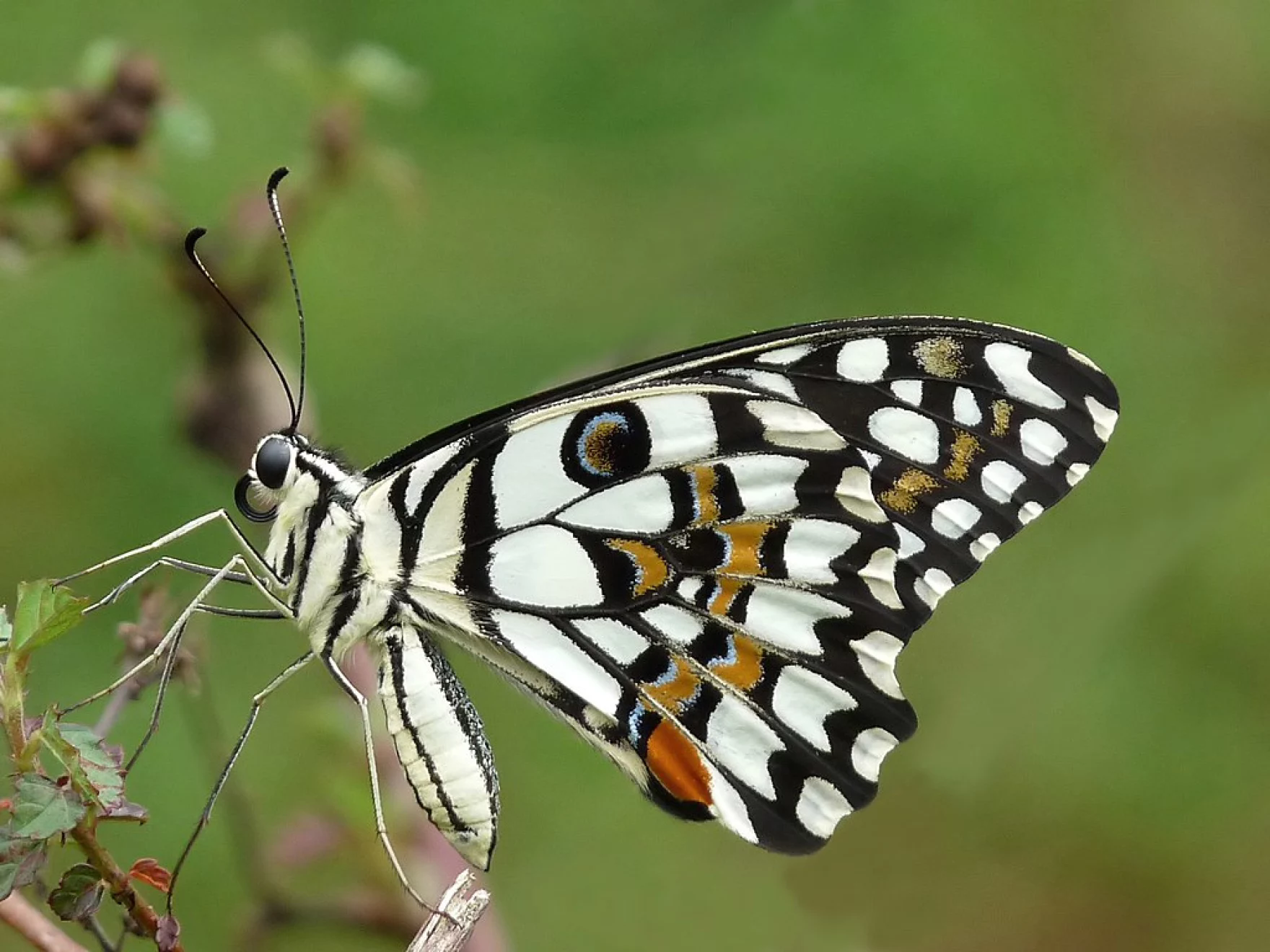
Papilio demoleus sthenelus is found only in Australia and, along with the subspecies in Papua New Guinea, utilizes different host plants than the Asian and African subspecies. The population in the Dominican Republic has been traced to a southeastern Asian subspecies (Eastwood et al. 2006). This species is also morphologically similar to Papilio demodocus Esper from Africa and Madagascar.
DISTRIBUTION
This species is found throughout tropical and subtropical regions of southern Asia, ranging from Saudi Arabia, Iran and the Middle East to India, Nepal, southern China, Taiwan, and Japan. It is also found in Malaysia, Indonesia, New Guinea, and Australia. In recent years, Papilio demoleus has been recorded in the Dominican Republic, Cuba, Puerto Rico, and Jamaica.
DESCRIPTION
ADULTS
The adult wingspan ranges from 80-100 mm. The hindwing has no tail. The upper portion of the forewing is largely black and the outer wing margin has a series of irregular yellow spots. Two yellow spots are present at the upper end of the discal cell with several scattered yellow spots in the apical region. The upper hindwing has a red tornal spot and the discal black band is dusted with yellow scales. The underside is paler yellow with the black areas more heavily dusted with yellow. The adults fly in every month but are more abundant after monsoons.

Credit: Marina Young, RADA, Jamaica
EGGS
The eggs are pale yellow, nearly spherical, about 1.5 mm, basally flattened, and smooth. Females lay eggs singly near the edges of the host plant leaves.

Credit: Marina Young, RADA, Jamaica
LARVAE
First through fourth instars are black with a black head, with two sub-dorsal rows of short fleshy spines and a dark brown, glossy head capsule. The anterior, middle, and posterior parts have broad transverse off-white bands, giving larvae a bird dropping camouflage pattern. There is an additional row of paired fleshy spines on the thorax. The head is brown, smooth and glossy, with short hairs.

Credit: Marina Young, RADA, Jamaica
Fifth instars take on a green coloration pattern distinct from the previous instars. Two pairs of fleshy spines are located posteriorly and again immediately behind the head. These spines are very short, and gradually change from yellowish-orange to green. They have rows of orange or pink spots edged with black laterally and subdorsally with black transverse markings located anteriorly, with more scattered black markings laterally and at the rear end. There is a white sub-lateral line along the abdominal area just above the legs. The fleshy spines are orange. The head is large and brown with a dull orange inverted V mark.

Credit: Kevin Burnette, FDACS
The osmeterium is yellow at the base to orange at the tips. This fleshy, forked structure is located on the head of the larvae of swallowtail butterflies. It is normally hidden but can be everted when the caterpillar feels threatened. It emits smelly compounds that deter some predators.

Credit: Marina Young, RADA, Jamaica
PUPAE
The pupae are stout, rugose, and about 30 mm long. They are attached to the thicker stems of the host plant, or to adjacent sticks and rocks. The color is dimorphic, typical for many swallowtails, being either pale green or pink-brown with other variable cryptic markings. The green form is usually marked dorsally with yellow. The color pattern imitates the dominant surrounding color to which the pupa is attached. The pupal duration is variable. In some areas, it is about 30 days in spring, reducing to 18 days in summer, but often those pupae formed in captivity during autumn will not produce adults until the following spring, or even longer with one record of 280 days.

Credit: Marina Young, RADA, Jamaica

Credit: Marina Young, RADA, Jamaica
LIFE CYCLE
This species typically has five instars and is capable of producing multiple generations per year depending on temperature constraints. Near the equator as many as nine generations may be seen. The average length of a generation varies from 26 to 59 days. In colder climates, pupae may overwinter.
HOSTS
Outside of Australia and New Guinea, Papilio demoleus feeds on plants in the Rutaceae family. It is known to feed on virtually all species and varieties of native or introduced citrus (including cultivated Citrus species), Glycosmis pentaphylla (Jamaica mandarin orange), Ruta graveolens (Rue, common rue, herb of Grace), Aegle marmelos (Bael fruit, Bengal quince, elephant apple, golden apple, holy fruit), Murraya koenigii (Indian curry-leaf tree, curry-leaf tree, curry-leaf, curry leaves, Indian curry leaves, Karapincha), and Chloroxylon swietenia (East Indian satinwood).
Papilio demoleus has been observed ovipositing on Citrus aurantium (bitter orange), and Citrus aurantifola (Key lime, Mexican lime, West Indian lime) (Common and Waterhouse 1972, 1982; Tsukada and Nishiyama 1982; Larsen 1984; Braby 2000; Rafi et al. 1999a; Rafi et al. 1999b; Rafi et al. 1999c; Rafi et al. 1999d). The potential suitability of additional cultivated and native New World Rutaceae including plants in the genera Amyris, Ptelea, and Zanthoxylum is unknown.
The Australian and New Guinean populations feed on Fabaceae. Some research suggests that these populations may be a distinct species, Papilio sthenelus MacLeay, so feeding on Fabaceae might not be applicable to true Papilio demoleus from Asia. They have been observed on species of Cullen (=Psoralea): Cullen australasicum (tall verbine), Cullen badocanum, Cullen balsamicum, Cullen cinereum, Cullen patens (spreading scurf-pea, native verbine), Cullen pustulatum, Cullen tenax (tough scurf-pea, emu-foot, emu grass), and Cullen leucanthum. They are also found on Soralea pinnata (fountain bush), and Microcitrus australis (Australian round-lime, Australian lime). They are known to oviposit on Rutaceae: Citrus aurantium (bitter orange), and Citrus aurantifola (Key lime, Mexican lime, West Indian lime).
ECONOMIC IMPORTANCE
The New World arrival of this vagile lepidopteran pest is a potential threat to the citrus industries in the region. The larvae are a serious pest of citrus nursery stock (trees 1-2 ft. in height) and other young citrus trees in Asia and the Middle East, where they are capable of defoliating entire nursery groves. Larvae may utilize young leaf flush on more mature trees.

Credit: Marina Young, RADA, Jamaica
MANAGEMENT
BIOLOGICAL CONTROL
Three parasitoids are known to parasitize Papilio demoleus larvae in India. They are Apanteles (=Ooencyrtus) papilionis, Apanteles sp. and Bracon hebetor (Hymenoptera: Braconidae).
In Thailand, two kinds of egg parasites were found: Ooencyrtus malayensis Ferriere (Hymenoptera: Encyrtidae) and Tetrastichus sp. (Hymenoptera: Eulophidae). A larval parasite, Erycia nymphalidophaga Baronoff (Diptera: Tachinidae), was found. Additionally, Brachymeria sp. (Hymenoptera: Chalcididae) and Pteromalus puparum Linnaeus (Hymenoptera: Pteromalidae) are pupal parasites. Other natural enemies of larvae found in Thailand were a predatory pentatomid bug, Cantheconidea furcellata (Wolff), reduviid bugs, spiders, sphecids, chameleons, and birds.
In Jamaica, an encyrtid egg parasitoid and a chalcidoid parasitoid have been reported.
The biopesticides Bacillus thuringiensis and Beauveria bassiana, as well as neem seed kernel extract and azadirachtin were shown to have effects on Papilio demoleus in India. Bacillus thuringiensis showed the highest level of control.
OTHER NATURAL METHODS OF CONTROL
Larvae are easily hand-picked from nursery plants, but this practice is labor intensive if infestation is high.
The category of vermin is clearly a shifting social construction as it includes different kinds of animals at different times. The shifting category of vermin results from the changing circumstances in which different animals come to be seen as evading human dominion, control, and order and thereby acquire the status of pests that must be eradicated. In other words, when animal agents infiltrate spaces controlled by humans and their agency constitutes a threat or nuisance to human ordering, a boundary is drawn between humans and those ‘unordered’ nonhumans. The work done by Fissell suggests three interrelated characteristics crucial to the category of vermin in the 17th century. The vermin devoured human food; it was clever and smart, and it possessed abilities to manipulate symbols and language.
In the case of the Lemon butterfly, its ability in the larval stages, to completely defoliate young citrus trees and devastate nurseries in which humans have invested considerable time and effort, makes it an economic pest. Looked at differently, the Lemon butterfly is a vermin because it is out of place as it invades human territories, and out of order as it creates a nuisance by devouring human plantations. My mother’s suggestion to escort the caterpillars out of the home came from the same line of thought. While the domesticated curry tree has found a refuge in the concrete pots in the urban, the larva has to be clever and still contest the human for refuge. For when confronted, the human and the caterpillar would stake claims on the domesticated leaves. The only difference being, for one, it is a matter of life and death, and for the other, it is about enhancing the flavor of the food.
To ease the pressure on the curry plant in my garden, I’m planning to relocate a few caterpillars to a larger citrus tree in a public park where they can chomp happily and complete their life cycles.

